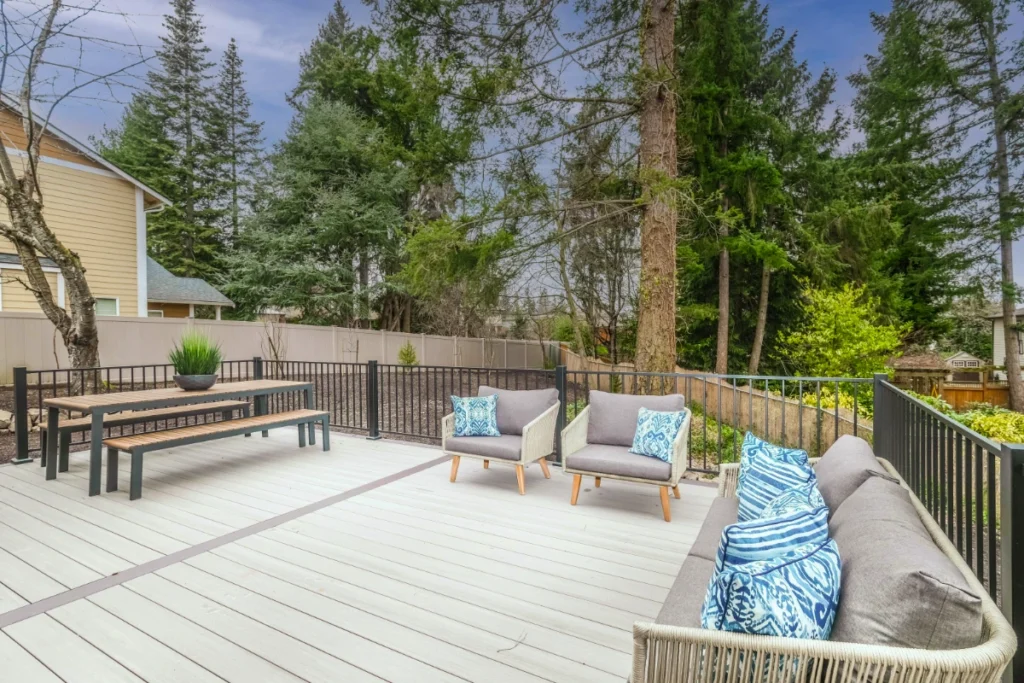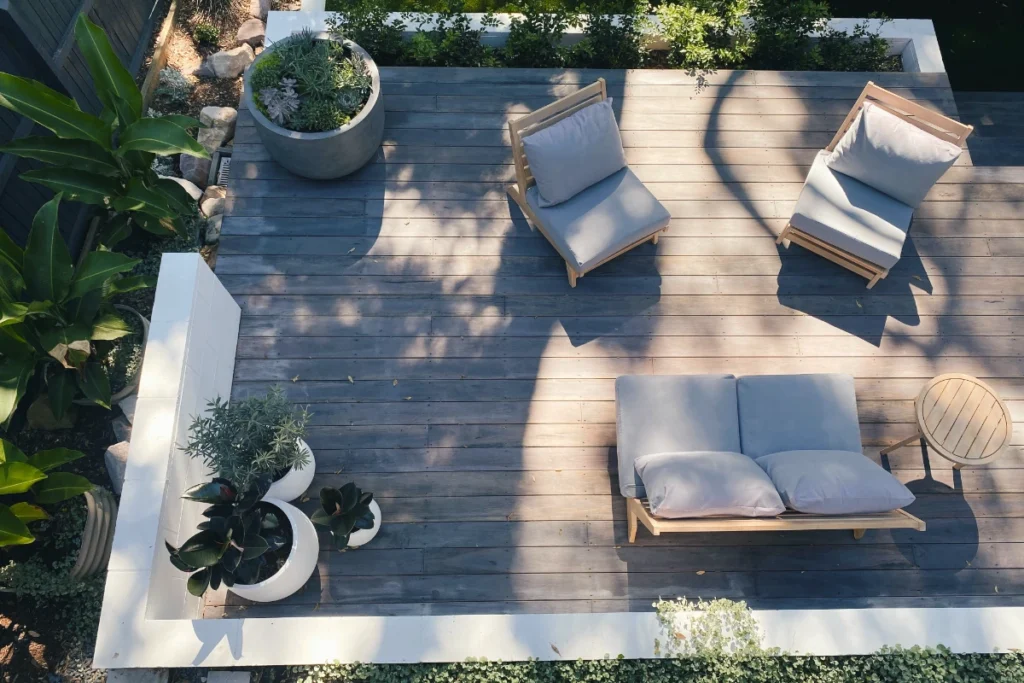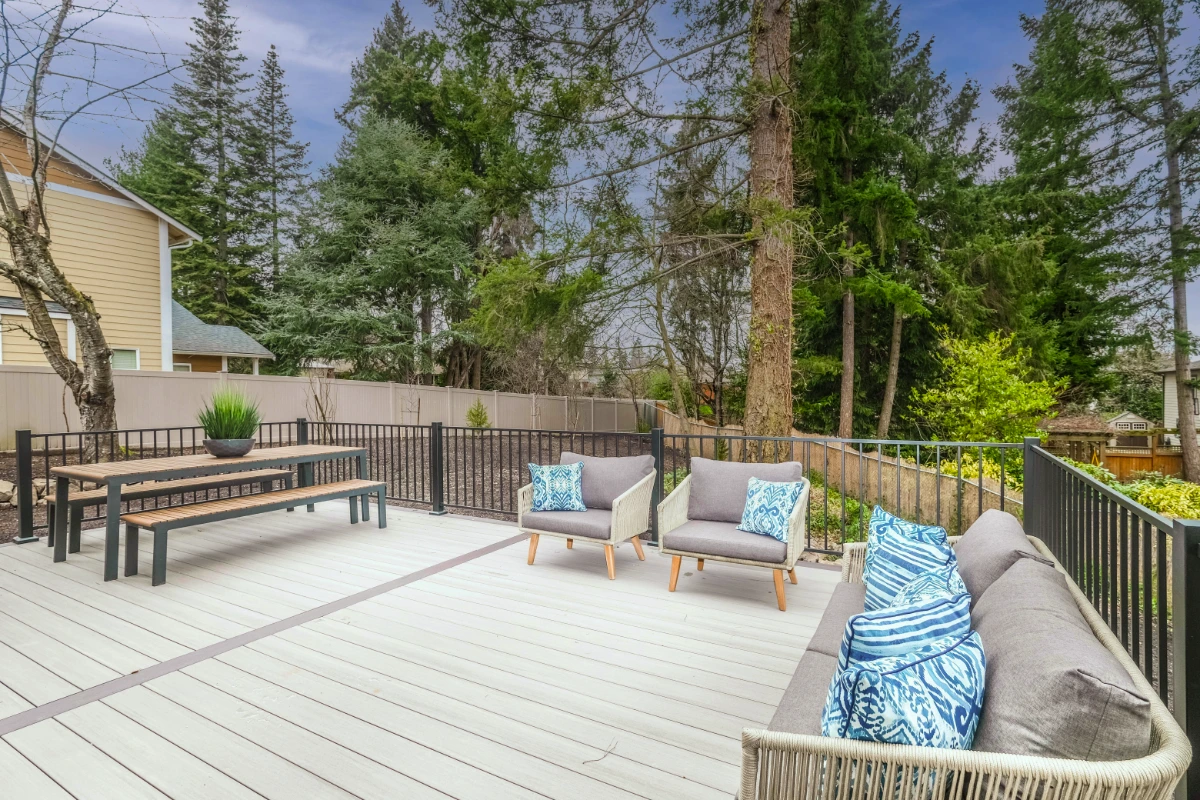If you’re anything like me, weekends are precious. The last thing I want to do is spend my Saturday staining a deck or replacing rotted boards when I could be relaxing with friends around a fire pit, grilling up some steaks, or just enjoying my outdoor space with a cold drink in hand.
That’s why I’ve become a huge advocate for low-maintenance deck designs. After building hundreds of decks during my contracting days, I’ve learned which materials, layouts, and features stand the test of time while requiring minimal upkeep.
Here are seven deck ideas that let you maximize enjoyment while minimizing maintenance. These designs work particularly well when paired with fire features and outdoor cooking spaces—our favorite weekend activities!

1. Composite Decking: The Weekend Warrior’s Best Friend
The single biggest game-changer in low-maintenance decking is composite materials. Modern composite decking has come a long way from the fake-looking options of the past.
Why I love it:
- Never needs staining or sealing
- Resistant to fading, scratching, and staining
- Won’t splinter, crack, or warp
- Available in a wide range of colors and realistic wood grain patterns
- Many options include built-in fade and stain protection
Real-world tip: I installed a Trex Transcend deck for a client seven years ago. They’ve done absolutely nothing to it except occasional cleaning with soap and water, and it still looks almost new. Yes, the upfront cost is higher than pressure-treated wood, but when you factor in the time and money saved on annual maintenance, it pays for itself within 5-7 years.
Design idea: Consider a two-tone design using complementary composite colors for the main deck and border. This creates visual interest without adding maintenance.
2. Platform Deck: Simple, Functional, Stress-Free
A ground-level platform deck (typically 16-24 inches off the ground) eliminates the need for railings in most jurisdictions while providing the perfect foundation for your outdoor living space.
Why I love it:
- No railing means fewer materials to maintain
- Perfect height for comfortable seating
- Creates a natural transition between your home and yard
- Ideal for integrating a fire pit or outdoor kitchen
- Simplifies future changes or additions
Real-world tip: Check your local building codes, but most areas don’t require railings for decks under 30 inches high. This single factor can reduce your maintenance burden by 30-40%.
Design idea: Create wide steps along one entire side of your platform deck instead of a narrow staircase. These serve as both access points and additional seating for larger gatherings.
3. Integrated Bench Seating: Built-in Convenience
Built-in benches eliminate the need for separate outdoor furniture while maximizing your usable space.
Why I love it:
- Reduces the amount of furniture you need to buy, maintain, and store
- Creates permanent seating that won’t blow away or deteriorate
- Can incorporate hidden storage underneath
- Forms a natural perimeter for your deck
- Provides a perfect frame for a central fire pit
Real-world tip: Build your benches using the same composite material as your deck for a cohesive look and matched durability. Include a slight slope on the bench seat (about 1/4 inch per foot) to prevent water from pooling.
Design idea: L-shaped corner benches create natural conversation areas when positioned around a central fire pit. Leave one or two sides open for traffic flow and to accommodate additional movable seating when needed.

4. Strategic Shade Solutions: Maintenance-Free Comfort
A carefully planned shade strategy keeps your deck comfortable without creating additional maintenance headaches.
Why I love it:
- Extends usable hours on hot, sunny days
- Protects deck surface from UV fading
- Creates distinct zones for different activities
- Can be adjusted seasonally or permanently installed
Options to consider:
- Retractable awnings: Offer flexibility but typically have the highest maintenance needs
- Pergolas with shade sails: Create architectural interest with minimal maintenance
- Strategically planted trees: Provide natural shade that improves over time (just keep them far enough from the deck to prevent root issues)
Real-world tip: One of my clients installed a pergola with removable shade sails. They use dark sails in spring/fall for warmth and light-colored sails in summer to reflect heat. The sails take 10 minutes to change and are stored in a deck box when not in use.
Design idea: Position your shade to cover seating and dining areas while leaving cooking areas (like your grill or outdoor kitchen) unshaded for better ventilation.
5. Integrated Lighting: Subtle, Practical, Low-Effort
Built-in lighting extends your deck’s usability into the evening hours without creating a maintenance burden.
Why I love it:
- Dramatically extends the hours you can enjoy your deck
- Creates ambiance for evening gatherings
- Improves safety around steps and transitions
- Modern LED options last for years with minimal energy use
Best low-maintenance lighting options:
- Recessed stair lights
- Under-bench LED strips
- Post cap lights
- Solar path lights around the perimeter
Real-world tip: Hard-wired lighting costs more upfront but saves significant maintenance compared to battery-operated or solar options that need frequent replacement. If running electrical lines isn’t feasible, look for high-quality solar fixtures with replaceable batteries.
Design idea: Create layers of light with different fixture types. Low recessed lights illuminate pathways, post caps define boundaries, and overhead string lights create ambient illumination for the entire space.
6. Minimal Railing Design: Less Is More
If your deck height requires railings, choosing the right style can dramatically reduce your maintenance burden.
Why I love minimal railings:
- Fewer components to clean and maintain
- Better views of your yard and landscape
- More contemporary aesthetic
- Often more affordable over time despite higher upfront cost
Low-maintenance railing options:
- Aluminum powder-coated railings
- Cable rail systems
- Glass panel railings
- Steel with minimal components
Real-world tip: Black aluminum railings with thin balusters almost disappear visually, especially at night, creating an unobstructed view while maintaining safety. They never need painting and can be cleaned with a quick spray from the garden hose.
Design idea: Mix materials for visual interest while keeping maintenance low. Composite posts with aluminum or cable rails offer the perfect balance of warmth and modern style.
7. Integrated Fire and Water: Focal Points That Function
Adding a fire pit, water feature, or both creates natural gathering spots while reducing the area of decking you need to maintain.
Why I love them:
- Create natural focal points for your deck design
- Reduce the total square footage of decking material
- Add ambiance and functionality
- Extend seasonal use of your outdoor space
- Become the natural center of gatherings
Low-maintenance options:
- Propane fire pits with lava rock or glass (no ash cleanup)
- Self-contained water features with hidden reservoirs
- Smokeless wood fire pits with easy ash removal
- Simple scupper fountains with minimal plumbing
Real-world tip: A circular deck design with a central fire pit not only creates a perfect gathering space but reduces deck square footage by about 25% compared to a rectangular deck with the same seating capacity.
Design idea: Create a “destination deck” with distinct functional zones connected by stepping stones or pathways rather than one massive deck surface. This approach creates visual interest while reducing materials and maintenance.
Bringing It All Together: The Ultimate Low-Maintenance Weekend Deck
My favorite low-maintenance deck design combines several of these elements:
- Composite decking material in a warm wood tone
- Platform design with wide steps instead of railings
- Built-in L-shaped bench seating with hidden storage
- Pergola with removable shade sails covering half the deck
- Recessed lighting in steps and under benches
- Central smokeless fire pit on a stone inlay
- Simple propane grill station with composite countertop
This design creates a perfect weekend gathering space that requires just a couple hours of cleaning each spring rather than days of staining, sealing, or repairs.
Maintenance Schedule for the Truly Lazy (Like Me)
Even the most low-maintenance deck needs some care. Here’s my minimalist approach:
Spring (1-2 hours):
- Wash the deck surface with soap and water
- Check for any loose fasteners or damaged boards
- Clean light fixtures
- Test and clean fire features
Fall (1 hour):
- Clear leaves and debris
- Cover or store cushions and accessories
- Clean and cover fire features
- Check lighting function as days get shorter
That’s it! Two hours in spring and one hour in fall, and your low-maintenance deck is good to go for another season of weekend enjoyment.
It’s About Time, Not Money
When considering deck options, many people focus solely on upfront costs. But the true cost includes your time—that precious weekend time you could be spending enjoying your deck rather than maintaining it.
A thoughtfully designed low-maintenance deck might cost 20-30% more upfront than a traditional pressure-treated wood deck, but it gives you back dozens of weekends over its lifetime. To me, that’s the best investment you can make in your outdoor living space.
What are your favorite low-maintenance deck features? Share in the comments below—I’m always looking for new ideas to minimize work and maximize enjoyment!
Relax on, Jake
